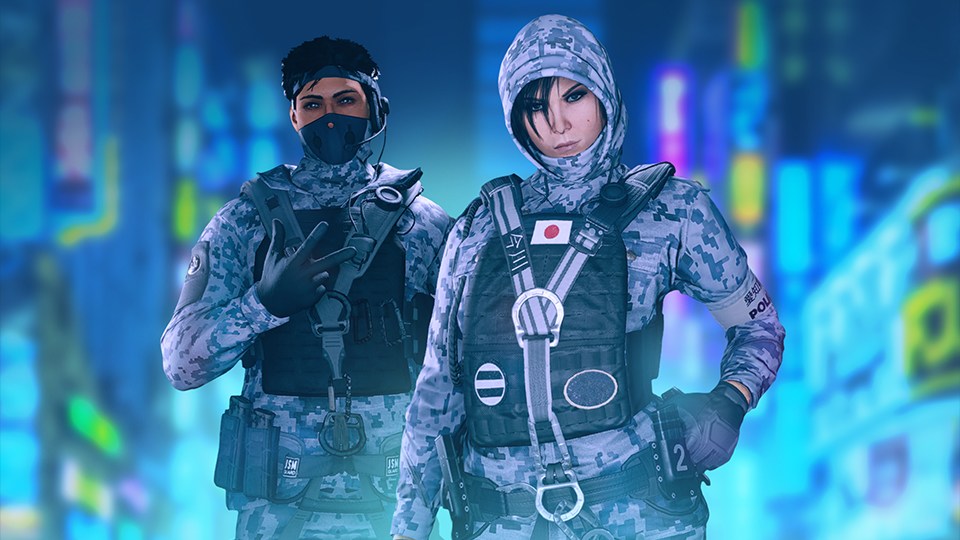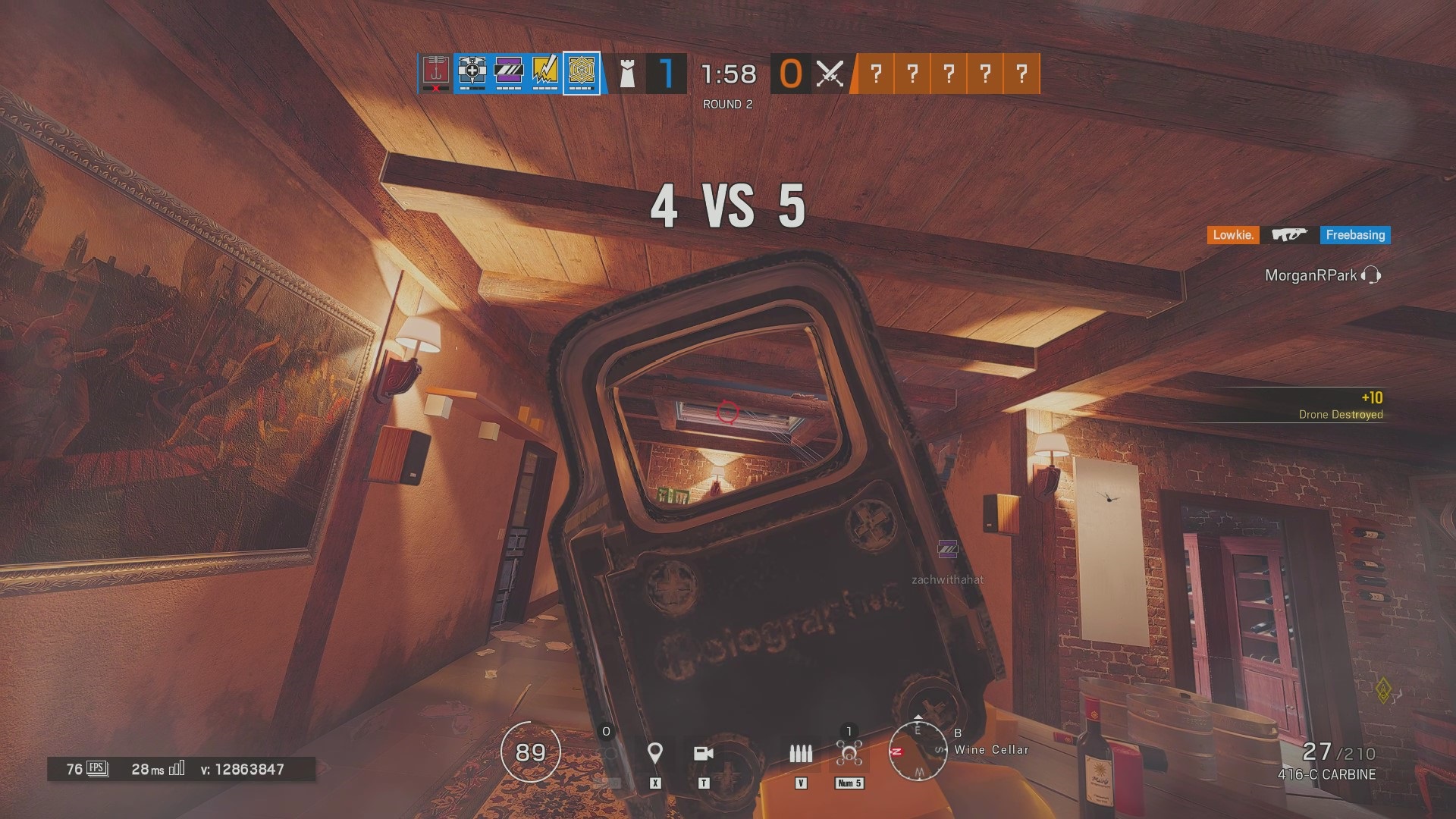Rainbow Six Siege players want Apex Legends' pinging, and Ubisoft likes the idea
Ubisoft will likely add contextual pinging “at some point,” but it’s not a priority.

Whatever you make of Apex Legends' meteoric rise, everyone can agree that it gets non-verbal communication right. With a simple button press, players can quickly make specific callouts (“enemy was here” or “need light ammo,” for example). The hugely positive feedback of contextual pinging has left Rainbow Six Siege players understandably jealous, and Ubisoft is taking notes.
Since Apex’s release, the Siege subreddit has been abuzz with requests for more ping options. There’s a bit of irony to acknowledge here—before Apex, Siege was one of the only competitive shooters around with a ping mechanic at all. Apex might be popularizing it, but the OG here is Siege and the Rainbow Six games that came before it. Its dedicated ping button creates a small yellow mark to indicate enemy locations, where shots were heard, where to breach a wall, or anything really. But Siege's pings lack any context unless they’re backed up by a vocal callout or laborious chat message.
For years, players have adapted by developing an imperfect language for interpreting pings. If a wall is marked on the objective, they’re probably suggesting someone reinforce or breach it. When a window is pinged in the first few seconds of an attack round, they’re probably calling out that the window is broken, signaling a spawn peeking defender trying to score an early kill.
But Ubisoft has been paying attention to Apex’s fluid comms. In an interview with Stevivor at the Six Invitational last month, game director Leroy Athanassoff said Ubi is exploring the idea of Apex-style pings in Siege. “We have a ping in our game, though I would love to be able to ping a reinforced wall and ask for a breach. For instance, maybe when I ping a wall I can open up a contextual wheel to select what to do, or alternatively be able to ping something like a Mute jammer,” he said. Athanassoff went on to say that they’ll probably implement a similar system “at some point,” but it’s not a priority.
Contextual pings aren't just a gameplay feature, they're an accessibility improvement.
Respawn's contextual pings work by varying their shapes, colors, and playing a character voice line that alleviates the need to get on the mic. Siege has the ingredients to replicate this, minus voice lines for its 46 characters. Pinging has a dedicated key and currently only works as a single press, so holding the button to bring up a ping wheel or double tapping for enemy marks wouldn’t cause complications, in theory. One of the best uses, I imagine, would be during the operator selection phase. Teammates could ping specific operators as suggestions and encourage better team compositions.
The loudest dissenters of the idea believe that Siege doesn’t need more reasons for players to unplug their microphones. After all, strong verbal communication is the backbone of a good team. Players have spent years building an unofficial catalogue of callouts for every single room and hallway across 20-plus maps. Learning the maps and winning a round because of good callouts is one of the greatest (and hard-earned) joys of the game. Some think contextual pings would shift the focus away from voice and trivialize the skill of making callouts. There's also the concern that a richer pinging system would clutter the screen with UI, creating unwanted distractions in some situations.

The worries are understandable, but I don’t believe an expanded ping system would somehow ruin Siege’s established culture of voice comms. Besides scanning enemies on cameras, pinging is only possible when players are alive. Contextual pings could absolutely replace voice comms for small callouts (“enemy here” or “breach that”), but round-winning callouts usually include details like which way an enemy's facing, whether or not an opponent is defusing, or whether a specific gadget is in a specific spot—details that would be tough to replicate with an automated system.
The biggest gaming news, reviews and hardware deals
Keep up to date with the most important stories and the best deals, as picked by the PC Gamer team.
Just because nuanced pings work in Apex doesn’t mean they’ll automatically make sense in Siege, so a good implementation would hinge on building a system that respects Siege's slower, stealthier gameplay. A few general options for breaching or calling out movement is probably all that's needed. To avoid too much UI noise, the new pings shouldn’t be any flashier than the ones it uses now. If you’re in a firefight and need to focus on what’s in front of you, they should always be ignorable.
Sometimes talking on mic as a girl results in me getting team killed or trolled. I’m a bit afraid to play ranked too much because it’s a 50/50 chance that this will happen, but I also get yelled at for not communicating since it’s important. Would LOVE something like this.March 24, 2019
But contextual pings aren't just a gameplay feature, they're an accessibility improvement. Having a way to communicate non-verbally is important for folks who stay off-mic because they experience harassment, have a speech impediment, or are just in an environment where they have to play quietly. Over the weekend I asked Twitter whether Siege should get Apex-style contextual pinging. Beyond all the people clinging to the “just use a mic” stance, the strongest responses I received were from women that have seen Siege’s ugly side. As of this writing, the poll has over 6000 votes with “yes” in a hefty 77 percent lead.
“Sometimes talking on mic as a girl results in me getting teamkilled or trolled. I’m a bit afraid to play ranked too much because it’s a 50/50 chance that this will happen, but I also get yelled at for not communicating since it’s important,” Siege fan Petra told me. “Would LOVE something like this.” Evan explores toxicity more in his story about Apex’s contextual pings from back at the game’s launch.
Overhauling something as fundamental as communication in Siege is a big step, and it’s likely far on the horizon. If done right, context-sensitive pings will feel like a natural extension of what we already have.

Morgan has been writing for PC Gamer since 2018, first as a freelancer and currently as a staff writer. He has also appeared on Polygon, Kotaku, Fanbyte, and PCGamesN. Before freelancing, he spent most of high school and all of college writing at small gaming sites that didn't pay him. He's very happy to have a real job now. Morgan is a beat writer following the latest and greatest shooters and the communities that play them. He also writes general news, reviews, features, the occasional guide, and bad jokes in Slack. Twist his arm, and he'll even write about a boring strategy game. Please don't, though.

